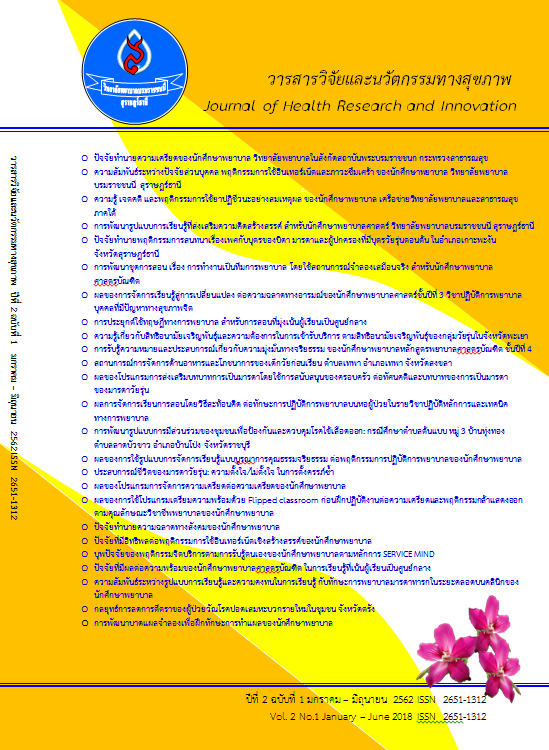ผลของการใช้โปรแกรมเตรียมความพร้อมด้วย Flipped classroom ก่อนฝึกปฏิบัติงานต่อความเครียดและพฤติกรรมกล้าแสดงออกตามคุณลักษณะวิชาชีพพยาบาลของนักศึกษาพยาบาล
คำสำคัญ:
พฤติกรรมกล้าแสดงออก, ความเครียด, โปรแกรมเตรียมความพร้อม, Flipped classroomบทคัดย่อ
การวิจัยครั้งนี้เป็นการวิจัยกึ่งทดลอง (Quasi-experimental Research) เพื่อเปรียบเทียบความเครียดและพฤติกรรมกล้าแสดงออกตามคุณลักษณะวิชาชีพพยาบาลก่อนและหลังการได้รับโปรแกรมตรียมความพร้อมด้วย Flipped classroom ก่อนขึ้นฝึกปฏิบัติงานในวิชาปฏิบัติการพยาบาลบุคคลที่มีปัญหาสุขภาพ1 ของนักศึกษาพยาบาลศาสตรบัณฑิตชั้นปีที่ 2 ปีการศึกษา 2561 วิทยาลัยพยาบาลบรมราชชนนี จังหวัดนนทบุรี กลุ่มตัวอย่าง คือ นักศึกษาพยาบาลศาสตรบัณฑิตชั้นปีที่ 2 จำนวน 28 คน คัดเลือกแบบเฉพาะเจาะจง เครื่องมือที่ใช้ในการทดลอง ได้แก่ โปรแกรมเตรียมความพร้อมด้วย Flipped Classroom ซึ่งผู้วิจัยพัฒนาขึ้น และให้ผู้ทรงคุณวุฒิจำนวน 5 คนตรวจสอบได้ค่าดัชนีความสอดคล้องเชิงเนื้อหา= 0.92 เครื่องมือที่ใช้ในการวิจัยประกอบด้วย 1) แบบสอบถามความเครียด ประยุกต์จากสราวุฒิ สีถาน และมาลินี บุญเกิด (Srithan, S., & Boonkerd . M., 2010) ได้ค่าดัชนีความสอดคล้องเชิงเนื้อหา= 0.70 และความเชื่อมั่นสัมประสิทธิ์แอลฟาของครอนบาคมีค่าเท่ากับ 0.96 และ 2) แบบสอบถามพฤติกรรมกล้าแสดงออกตามคุณลักษณะวิชาชีพพยาบาล ประยุกต์จาก เนตรนภา กาบมณีและคณะ, (2560) ได้ค่าดัชนีความสอดคล้องเชิงเนื้อหา=0.92 และความเชื่อมั่นสัมประสิทธิ์แอลฟาของครอนบาคมีค่าเท่ากับ 0.88 สถิติที่ใช้ในการวิเคราะห์ข้อมูลคือ สถิติเชิงพรรณนา และ dependent paired t-test
ผลการวิจัยพบว่า 1) ภายหลังใช้โปรแกรมการเตรียมความพร้อมด้วย Flipped Classroom มีค่าคะแนนเฉลี่ยระดับความเครียดลดลงกว่าก่อนใช้อย่างมีนัยสำคัญทางสถิติ (p<.05) 2) ภายหลังใช้โปรแกรมการเตรียมความพร้อมด้วย Flipped Classroom มีค่าคะแนนเฉลี่ยของระดับพฤติกรรมกล้าแสดงออกตามคุณลักษณะวิชาชีพพยาบาลเพิ่มขึ้นกว่าก่อนใช้อย่างไม่มีนัยสำคัญทางสถิติ ผลการวิจัยสามารถนำใช้ประโยชน์เพื่อพัฒนาการเรียนการสอนภาคปฏิบัติในการเตรียมความพร้อมของนักศึกษาก่อนขึ้นฝึกปฏิบัติงานได้อย่างมีประสิทธิภาพและเหมาะสมกับบริบทต่อไป
เอกสารอ้างอิง
Wongsare, C., (2015). Generation Z CLINICAL TEACHING IN ADULT NURSING PRACTICUM COURSE FOR GENERATION Z COLLEGIAN. Journal of Boromarajonani College of Nursing, Bangkok, 31(2), 130-140. Retrieved 2019, 5 May, from https://www.tci-thaijo.org/index.php/bcnbangkok/article/view/47641 (in Thai)
Chutima Anantachai at.al. A STUDY OF STRESSORS STRESS LEVEL AND COPING STRATEGIES IN CLINICAL NURSING PRACTICE OF NURSING STUDENTS OF VONGCHAVALITKULUNIVERSITY. Retrieved 2019, May 5, from http://www.vu.ac.th/Joural/54feb-54jun/journal03.pdf. (in Thai)
Prakobkit, K., & Itsariyapanan, D., (2013). Perception of nursing students on their nursing skills and their professional attitudes after their first clinical practice, Faculty of Nursing, Bangkokthonburi University. Retrieved 2019, May 5 from http://research.bkkthon.ac.th/abstac/ab_17102558114711.doc. (in Thai)
Pulido-Martos, M., et al, (2012). Sources of stress in nursing students: a systematic review of quantitative studies. International Nursing Review 59, 15–25
Limthongkul, M., & Arreeaiu, S., (2010). Stress source Coping methods and Coping results of nursing students in the first practical training. Rama Nurs J, 15(2), 192-205. (in Thai)
Rungnoe, N., & Seesawang, J., (2016). Effects of Self-development Supportive for the Pre-practicum Preparation at Intensive Care Unit on Knowledge and Skills among Nursing Students. Journal of Phrapokklao Nursing College, 27(2), 29-38. (in Thai)
Kaewin, N., & Hongprasit, P., (2010). Nursing Students’ Expectation and Reality Towards Nursing Teachers in Ward Practice of Principles and Techniques in Nursing Practicum of the 18th Class, the Second Year students, Boromarajonani College of Nursing, Udon Thani. Retrieved 2019, May 5 from http://newtdc.thailis.or.th (in Thai)
Kabmanee, N., et al., (2017). NURSING PROFESSIONAL CHARACTERISTIC ASSERTIVENESS AND THE ACADEMIC ACHIEVEMENT OF THE FOURTH YEAR STUDENT NURSE AT BOROMARAJONANI COLLEGE OF NURSING, UDONTHANI. Retrieved 2019, May 5 from http://www.journal-social.mcu.ac.th/wp-content/uploads/2017/11/Article-12-Natenapa-Kabmanee.pdf (in Thai)
Sharma, N., & Kaur, A., (2011) Factors associated with stress among nursing students. Nursing and Midwifery, Research Journal, 7 (1): 12-20 (in Thai)
Jantavat, P., (2018). Preparation of Nursing Student for Stress Relief during Practice in Delivery Room. Kuakarun Journal of Nursing . 25 (1), 184-191 (in Thai)
Khatesalee, R., (2009). A Study and Development of Nurses Assertive Behaviors Using Transactional Analysis. Retrieved 2019, May 5 from http:// ww.bnc.ac.th/knowledge/wp- content/uploads/.../Flipped-Classroom_ก.ย.-56.pdf (in Thai)
Srithan, S., & Boonkerd, M., (2010). The Effect of Readiness Preparation for Nursing Practice in Ward of 2nd year nursing students, Boromarajonani college. Retrieved 2019, May 5 from http://tdc.thailis.or.th
Jamjang, S., et al., (2019). The Effect of Readiness Preparation for Nursing Practice in Ward of 2nd year nursing students, Borommarajonnani college of Nursing, Ratchaburi. Nursing Journal of the Ministry of Public Health. 20(3), 147-163 (in Thai)
Udomphol, S., (1994). Effects of Kelley's assertive training program on the third year nurse students assertive behavior Retrieved 2019, May 5, from http://cuir.car.chula.ac.th/handle/123456789/48826 (in Thai)
Sririwanit, W., et al., (2010). Preparation by reviewing for practice in nursing, maternal and infant nursing and midwifery 1. Retrieved from http://110.164.66.211/ULIB6/searching.php (in Thai)
Panit, W., (2013). Teachers for students to create a Flipped classroom. Retrieved 2019, May 5 from https://www.edulpru.com/eu/21st/st-004.pdf (in Thai)
Paha, S., (2012). Flipped Classroom: Classroom Dimension New in the 21st century. Retrieved 2019, May 5, from http://www.mbuisc. ac.th/phd/academic/flipped%20 ssroom2.pdf.
Tantalanukul, S., & Wongsawat, P., (2017). Stress and Stress Management in Nursing Students. Boromarajonani College of Nursing, Uttaradit Journal. 9 (1): 81-92 (in Thai)
Sonprasom, S., (2017). Satisfaction on the use of Classroom in Physics I for Engineering Students. RSU National Research Conference 2016. Retrieved 2019, May 5 from https://rsucon.rsu.ac.th/files/proceedings/nation2016/G5-07.pdf (in Thai)
Kaneko, S., & Momino, K., (2015). Stress Factors and Coping Behaviors in Nursing Students during Fundamental Clinical Training in Japan. International Journal of Nursing & Clinical Practices, 2: 138: 1-7
Tirapaiwong, Y., Mitsumpune, N., Nilwachalamanee, C., & Sirisupalux, P., (2014). USAGE AND BARRIER OF USING INFORMATION AND COMMUNICATION TECHNOLOGY (ICT) FOR TEACHING AND LEARNING OF INSTRUCTORS IN BACHELOR OF NUR. Journal of Boromarajonani College of Nursing, Bangkok, 30(3), 77-86. Retrieved from https://www.tci- thaijo.org/index.php/bcnbangkok/article/view/30258 (in Thai)
Phothidara, Y., (2011). Nursing Education Management: For Student Generation Y. Journal of Nursing Science & Health. 34 (2): 61-69 (in Thai)
ดาวน์โหลด
เผยแพร่แล้ว
รูปแบบการอ้างอิง
ฉบับ
ประเภทบทความ
สัญญาอนุญาต
บทความที่ได้รับการตีพิมพ์เป็นลิขสิทธิ์ของวารสารวิทยาลัยพยาบาลบรมราชชนนี สุราษฎร์ธานี
ข้อความที่ปรากฏในบทความแต่ละเรื่องในวารสารวิชาการนี้เป็นความคิดเห็นส่วนตัวของผู้เขียนแต่ละท่านไม่เกี่ยวข้องกับวิทยาลัยพยาบาลบรมราชชนนี สุราษฎร์ธานี และคณาจารย์ท่านอื่นๆในวิทยาลัยฯ แต่อย่างใด ความรับผิดชอบองค์ประกอบทั้งหมดของบทความแต่ละเรื่องเป็นของผู้เขียนแต่ละท่าน หากมีความผิดพลาดใดๆ ผู้เขียนแต่ละท่านจะรับผิดชอบบทความของตนเองแต่ผู้เดียว



